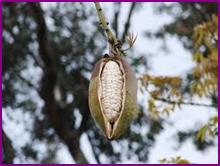KAPOK REDISCOVERED
Kapok is not strange to fly tyers. It was used England in the late 1890s and in this country since the early 1900s. It was and is used in fly tying because of its extreme buoyancy. Let's take a closer look at this old material that is still available.
Kapok comes from the fruit of the Ceiba pentandra tree. The content of the fruit is referred to as kapok or Java cotton. This deciduous tree primarily grows in South America but is also found in Mexico, Central America, the Caribbean, Asia, Indonesia and Africa. Approximately every five years or so, the tree blossoms and produces large fruits. As the fruits dry they eventually split open reveling the soft, water resistant, buoyant, natural silky material that we call kapok. The tree can grow to over two hundred feet tall and is capable of living up to three hundred years. Each tree is capable of producing up to four thousand fruits.
 Kapok has many uses. It is used in life vest, furniture, pillows, insulation and mattresses.
Kapok has many uses. It is used in life vest, furniture, pillows, insulation and mattresses.
The seeds also produce oil that can be used in the production of soaps and fertilizers. Its importance today has decreased with the development of rubber, man-made fibers, plastics and foams.
Kapok is still used in fly tying, however, for unknown reasons its popularity has waned. I still use it to tie underbodies on flies that I use in rough waters. Lately, I've even incorporated into many of my standard patterns. It weighs one-sixth as much as cotton, floats five times better then cork and will support up to thirty times its own weight in water.
A search of the internet will reveal that there are still some patterns that tyers use it for.
I have not yet tried to dye it --- but, the internet reveals that it can be dyed easily. It's hard to acquire in small quantities but an excellent source for natural kapok can be found in old personal flotation devises or life preservers. Look around at marinas or garage sales. One old life vest will give you more kapok then you can ever use in your life time.
Kapok has a texture of a fine dubbing and the color similar to 'Cahill.' It can be used as an underbody on most every fly you tie. Try it once and you'll be convinced.
See you on the water…..
Tom Deschaine
~www.michigandryflies.net~ copyright2012©Deschaine
